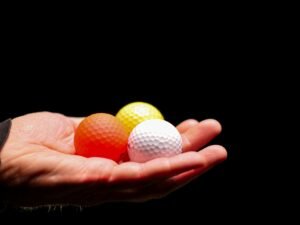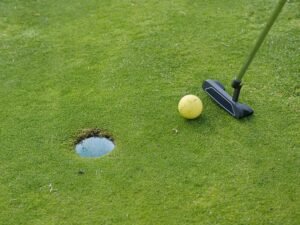
I hope you enjoy reading this blog post.
If you are looking professional golf manufacturer.
How Do You Know If The Ball Is In An Immovable Obstacle Zone In Golf?
April 18, 2025
In this challenging and elegant game of golf. Accurately determining whether the ball is in an immovable obstacle area is a necessary skill for every player to move to the next level. This judgment is crucial, it is like the key position in a chess game, directly left and right stroke strategy.
Once the judgment is wrong, the player is likely to face a penalty, which will have a significant impact on the final result of the game. So, how can we practice the ability to make accurate judgments? Here, we’ll take a closer look at the key points.
Define The Extent Of Immovable Obstructions
The first step of judgment is to determine the extent of immovable obstructions. This type of obstruction mainly includes those artificially constructed facilities that are difficult to move easily.
The artificial roads and passageways on the course come in a variety of forms, with wide, flat, silver-ribbon stretches of asphalt on which cars travel, making a slight noise of tires rubbing against the ground. There are also winding stone roads full of natural charm. The stones clattered under the players’ feet as they walked.
These roads, with their solid surfaces, contrast sharply with the surrounding green velvet carpet of soft grass. Without exception, it falls under the category of immovable obstructions. Take a look at the architecture inside the stadium, starting with the simple sunshade pavilion. Let the players have a short rest in the hot sun, sheltered from the wind and rain.
There may only be a few benches in the pavilion, but it can bring a moment of cooling to tired players. To the large scale, unique architectural style, fully equipped clubhouse. No matter the size or complexity of the function, they are immovable obstructions.
An in-depth look at the stadium facilities reveals that sprinkler heads in the irrigation system are scattered throughout the stadium. They stand quietly like loyal guards.
Once opened, it will become a dynamic water spirit. Spray clear water evenly on the green lawn to nourish every inch of land. A drain for drainage, or cleverly hidden underground. Silently shouldering the burden of draining and keeping the site dry. Or exposed to the surface, with a unique line to outline the drainage vein of the court.
Control irrigation box, internal precision instrument precisely control irrigation time and water quantity. Like the “water brain” of the stadium. There are also stakes and protective stakes (it should be noted that the white stakes outside the demarcation boundaries are not included).
They stand upright like loyal sentinels guarding the boundaries of the pitch. The wall or winding, like a smart dragon around. Or extend straight, such as the resolute wall separating the inside and outside, the stadium and the outside world are moderately separated. Railings and fences with their own unique shape, or simple modern, to show the fashion atmosphere.
Or quaint and elegant, exuding historical charm, decorating and guarding specific areas of the stadium, all fall within the definition of immovable obstructions. Even those golf carts that are not used by the players themselves, or neatly left idle in the parking area, are quietly waiting to be used.
Or shuttling from fairway to fairway, carrying players to various shots. Lawnmowing mowers work with a constant buzz, meticulously trimming the lawn neatly. Due to special circumstances, the car that accidentally entered the court appeared to be somewhat out of place on the green court.
The garbage bins used by the roadside for garbage collection may also be printed with eye-catching environmental slogans. Directional signs clearly indicate the orientation of each area. The bench for people to rest, silently witnessing the laughter and sweat of the players.
These seemingly scattered facility objects are also included in the ranks of immovable obstructions without exception. So, once the ball lands on these objects, or stays near them, the player must be immediately alert.
Because the ball is most likely to have entered the immovable obstruction area, the subsequent batting action needs to be treated with caution.
Determine The Position Of The Ball According To The Specific Situation
After accurately defining the extent of the obstruction. The next step is to determine the position of the ball on a case-by-case basis, when the ball does land on an immovable obstacle. Or when stuck in a corner of it, the judgment of the situation is relatively simple.
Like, it’s like a magic spell. The ball fell into the small, well-proportioned groove of the nozzle and stuck firmly, unable to move. Or like a curious little fellow stuck in the dense, scattered crevices of the fence. No matter how anxious the player was, it was unmoved. Faced with such a scenario, it is obvious that the ball is in the immovable obstacle zone.
There is also a common situation if the obstruction obstructs the player’s stance when hitting the ball. The player fully expects to find a comfortable and compliant standing position, but because of the presence of obstacles, it is difficult to do so.
Or in the area of the player’s carefully anticipated swing, the obstruction interferes with the originally smooth and natural swing. Makes the player’s swing like a stuck old gear, making a crunch sound, difficult to complete smoothly. In both cases, the ball can also be considered to be in an immovable obstacle zone.
It is worth mentioning that the green, as the core area of the golf course, its judgment is slightly different. When an immovable obstacle appears along a player’s carefully planned putt route, it means that the ball is in the immovable obstacle zone. Let’s imagine a scenario where there’s a manhole cover on the putting green.
On weekdays it sits there quietly, so low profile that one can almost ignore its existence. But when the player is focused on preparing to push, the position of the manhole cover is like an invisible but indestructible barrier, which interferes with the direction of the push. This makes the originally smooth push plan have to be adjusted, and this situation fully meets the above criteria.
However, the golf course is full of variables, in the actual playing process, there are some special circumstances. It is very easy to confuse players and needs extra attention. If the ball becomes difficult, it is found that it is not directly caused by an immovable obstacle.
It is caused by other unexpected objects, such as a sudden bird that grabs the ball, or a small animal that suddenly bursts out of the court and changes the position of the ball.
In this case, the ball cannot be considered to be in the area of a remediable immovable obstacle. Also, if a player takes an unnecessary stance while hitting the ball. Such as standing on one foot, trying to pursue a unique sense of strength, while ignoring stability.
Or choose an unconventional swing that does not conform to the normal batting principle. Such as excessive twisting of the body to swing, not only difficult to play the normal level, but also may cause harm to the body.
Or deliberately set the direction of a very specific, almost tricky ball. Such as deliberately hitting the ball in the direction of an obstacle in the corner of the court, and then being affected by an immovable obstacle. In such cases, the ball is also not considered to be in the recoverable zone.
It is important to emphasize that every decision on the golf course cannot be made solely on the basis of a player’s subjective feelings or unverified experience. In the world of golf, all decisions must follow the rules of golf.
The rules are like a mirror hanging above the game, judging the position of each ball impartially and perceptively. So, when a player on the court has doubts about the position of the ball. Don’t make blind judgments, so as not to be wise and foolish.
The most sensible thing to do is to seek the help of the professional referee who is equipped with the stadium. They are professionally trained, know the rules by heart, and can interpret them accurately.
Or ask the staff who are familiar with the rules of the stadium, who have worked at the stadium for a long time and know the conditions inside the stadium. These professionals are able to make authoritative and impartial decisions based on rules.
To ensure that the competition can be conducted smoothly in a fair, just and orderly environment. So that every player can enjoy the unique charm of golf without distractions under the solid protection of the rules.
In summary, accurately determine whether the ball is in the immovable obstacle zone. For every golf lover, it is undoubtedly a key link to improve the competitive level. Mastering this skill both allows players to play on the field according to the actual situation.
Cleverly and flexibly optimize the batting strategy, just like a wise general devising strategies and flexibly arranging troops on the battlefield. It also allows players to enjoy the unique charm brought by golf without distractions under the premise of strict compliance with the rules.
Feel the challenge and fun of every shot, immerse yourself in the world of elegance and passion created by golf, and write your own chapter of golf legend.
FAQS
How do I choose the right golf ball for my skill layer?
Beginners should start with two-layer balls for ease of use and affordability. Intermediate players might benefit from three-layer balls for better control.
Advanced players can explore four or five-layer options to enhance their performance.
Are more layers always better?
Not necessarily. While more layers can offer advanced performance features, they may not be suitable for every player.
Beginners might find multi-layer balls harder to control, while more experienced golfers can benefit from the added complexity.
What is Fuli lead time?
Usually, we ship orders in 2 weeks. But it will take a little longer if we have the heavy burden of production tasks. It also takes more time for customized products.
Can the weather affect the choice of golf ball?
Absolutely. In colder weather, a softer ball might provide better feel, while in warmer conditions, a firmer ball might maintain distance better.
Additionally, wet conditions may call for balls that offer better traction and control.
How often should I change my golf balls?
Golf balls should be replaced if they show visible signs of damage (scrapes, cuts) or if you notice a decline in performance.
Regular players may want to change balls every few rounds, while casual players can go longer.
Leave a Reply
Your email address will not be published. Required fields are marked *

Are you looking for
GOLF BALL?
Offers Suitable Golf For Wholesalers And Professionals















